|
I. Introduction
Muslim sources are quite unanimous in stating the fact that
the text of the earliest masāhif was in bare consonantal form
– devoid of diacritics (i‘jām) to distinguish homographs and
bereft of vowels markings (tashkīl or i‘rāb) to discern
declensions. The script which needed a total of twenty eight
constants from the available fifteen graphemes, and which was thus without
matres lectionis
posed difficulty for non-Arabs. In order to avoid misreading
of these masāhif, vocalization and diacritics
were gradually introduced in the script. This process began
about three decades after the demise of Muhammad (sws) and was
completed in about the next one hundred years.
In this article, an attempt will first be made in the light of
primary source books to trace these major phases of the
development of Qur’ānic orthography specifically related to
vocalization and diacritics. Later this account will be
critically evaluated. The discussion will end on a conclusion.
II. The Traditional Accounts
In the light of the early sources, the phases of development
of Qur’ānic orthography specifically related to vocalization
and diacritics can be chronologically divided into the
following three:
A. The First Vocalization Phase
B. The Diacritics Phase
C. The Second Vocalization Phase
Details follow.
A. The First Vocalization Phase
Almost all Muslim authorities are of the opinion that the
first person to introduce vocalization on the masāhif was a
Basran poet and literary figure called Abū al-Aswad Zālim ibn
‘Umar al-Dū’alī (d. 69 AH). He embraced faith when the Prophet
(sws) was alive but was never able to see him.
He was a close companion of ‘Alī (rta) from whom he has
reported to have learnt the basic rules of Arabic grammar and
then formally documented them.
Majority of the sources mention that it was at the behest of
Ziyād ibn Abīh (d. 53 AH), the Basran governor of the Umayyad
caliph Mu‘āwiyah ibn Abū Sufyān (d. 60 AH) that Abū al-Aswad
undertook this task,
while a very minority opinion is that he did it at the behest
of the Umayyad caliph ‘Abd al-Malik ibn Marwān (d. 86 AH).
Muhammad ibn ‘Ubaydullāh ibn ‘Amr al-‘Utbī (d. 228 AH) has
recorded in detail this event of first vocalization:
حدثني أَبي قال : حدثنا أَبو عكرمة قال :
قال الْعُتْبي : كتب مُعاوية إلى زياد يَطلبُ عبيد الله ابنه ،
فلما قدِم عليه كلّمه فوجَده يلحَن فرده إلي زياد ، وكتب إليه
كتاباً بلومه فيه ، ويقول : "أمثلُ عُبَيْد الله يُضَيع".فبَعث
زياد إِلى أَبي الأسود فقال له : يا أَبا الأَسود ، إِن هذا
الحمراء قد كثُرتْ وأفسدَت من أَلسُن الْعرب فلو وضعتَ شيئاً
يَصلِح به الناس كلا مهم ويُعربون به كتاب الله. فأَبى ذلك أَبو
الأَسود وكره إجابة زياد إلي ماسأَل. فوجه زياد رجلاً وقال له :
اقعُد في طريق أَبي الأَسود فإِذا ربك فاقرأ شيئاً من القرآن
وتعمد اللحن فيه ففعل ذلك ، فلما ربه أبو الأسود رفع الرجل صوته
يقرا : (أَن اللهَ بَرِي مِّن المشركين و رَسوله) فاستعظم 10
/ أ ذلك أَبو الأَسود وقال : عزَّ وجه
الله أَن يَبرا من رسولِه ، ثم رجع من فوره إلى زياد فقال له :
يا هذا قد أَجبْتُك إلي ما سأَلتَ ، ورأَيت أَن أَبدأَ باعراب
الْقرآن فابعَثْ إِليّ بثلاثين رجلاً. فأَحضَرَهم زياد فاختار
منهم أَبو الأَسود عشرة ثم لم يزل يختارُهم حتى اختار منهم رجلا
من عبد القَيْس فقال : خُذ الْمُصحف وصِبْغاً يخالفُ لون المِداد
، فإِذا فتحتُ شفتيّ فانقُط واحدة فوق الحرف ، وإذا ضممتُها
فاجعل النُّقطة إِلى جانب الحرف ، وإذا كسرتُها فاجعل النُقطة في
أَسفله ، فإِن أَتبعْتُ شيئاً من هذه الحركات غنَّة فانقط نقطتين
. فابتدأَ بالمصحف حتى أَتي على آخره ثم وضع المختصر المنسوب
إليه بعد ذلك.
‘Utbī stated: “[Once] Mu‘āwiyah (rta) wrote a letter to his [Basran
governor] Ziyād [ibn Abīh] to call over his son ‘Ubaydullāh
ibn Ziyād to him. When the latter came over to him, he spoke
to him and detected many mistakes in his language; Mu‘āwiyah (rta)
sent him back to his father. He then wrote a letter to Ziyād
censuring him in it and said: ‘[Those] like ‘Ubaydullāh should
be done away with.’ Ziyād then wrote to Abū al-Aswad and said
to him: ‘These non-Arabs have increased a lot and have spoiled
the language of the Arabs; I wish you could do something
through which people correct their language and correctly read
the Book of God.’ However, Abū al-Aswad refused to do so and
showed his dislike in responding to Ziyād’s request. So Ziyād
went to a person and asked him: ‘Sit beside Abū al-Aswad’s way
and read something from the Qur’ān and intentionally make a
mistake in reading it.’ When Abū al-Aswad passed by that way,
the person loudly read the following Qur’ānic verse:
أَنَّ اللّهَ بَرِيءٌ مِّنَ الْمُشْرِكِينَ
وَرَسُولِهِ.
When Abū al-Aswad heard this, he got very alarmed and said:
‘God’s countenance is more powerful than to show acquittal to
His Messenger.’ He then immediately came to Ziyād and said: ‘I
will do what you asked for and I will vocalize the Qur’ān (put
i‘rāb on it); so send over thirty people.’ Ziyād duly provided
him with these. From these thirty, Abū al-Aswad selected ten
and continued [to test them] until from these ten, he selected
a single individual from the tribe of ‘Abd al-Qays.
He asked this person: ‘Take a mushaf and some ink which should
be of a different colour than the colour of the script. When I
open my lips, write a dot on top of the letter; when I close
both lips, write a dot adjacent to that letter; when I lower
my lips write a dot below that letter; If I follow up these
signs with [the sound of] nunation (ghunnah), write two dots
[accordingly].’ So Abū al-Aswad began with this task with a
mushaf until he came to the end. Then he wrote a concise book
ascribed to him [on this subject].”
Mūsā Shāhīn Lāshīn attributes this whole incident to around 48
AH while referring to an unspecified source.
Some other secondary sources mention that whenever this scribe
would complete one page, Abū al-Aswad would check it.
Jurjī Zaydān has mentioned seeing a Kufic mushaf dotted
according to this scheme of Abū al-Aswad written on thin
parchment at the Dār al-kutub al-misriyyah which was actually
found at a mosque in Cairo.
It is also surmised by some scholars from the description of
the endeavour undertaken by Abū al-Aswad that he only
vocalized the last letter of words.
In the opinion of Lāshīn,
it was ‘Abd al-Malik ibn Marwān who asked his Iraqī governor
al-Hajjāj ibn Yūsuf (d. 95 AH) to stop tashīf which was still
creeping in and people were making mistakes in reading. Lāshīn
says that around 80 AH al-Hajjāj summoned Nasr ibn ‘Asim al-Laythī
(d. 89 AH) who then vocalized every letter of a word so as to
minimize reading errors.
Hifnī Nāsif (d. 1337 AH) is of the opinion that the nuqat
(dots) of Abū al-Aswad were generally adopted in the masāhif;
as far as other books were concerned, they were rarely
adopted.
He goes on to point out some of the innovations made by the
followers of Abū al-Aswad in adopting his methodology of nuqat.
Some of them adopted a square shape for representing the nuqat
and others adopted a hollow circular shape and some others a
non-hollow circular shape. More orthographic signs were added
by his followers to represent sukūn and alif al-wasl.
In this regard, we also find scholars engaged in a discussion
about the origination of these nuqat. Some of them are of the
opinion that Abū al-Aswad was not the originator of the nuqat.
He only applied this methodology which he learnt from the
Syrians who used them in their own language: Syriac.
Some scholars are of the view that he was the originator of
this methodology.
Some other scholars are of the view that he only revived this
methodology which he learnt from the Arabs and which was in
vogue in Arabia earlier.
B. The Diacritics Phase
Perhaps the earliest source which mentions anything about the
insertion of diacritics to distinguish similar characters in
the mushaf is Kitāb al-tanbīh ‘alā hudūth al-tashīf of Hamzah
ibn al-Hasan al-Asbahānī (d. 360 AH).
It records the reason for insertion of diacritics: more than
forty years passed after the five ‘Uthmānic Qur’āns were
written and sent to various parts of the empire till the era
of ‘Abd al-Malik ibn Marwān arrived. During this time, a lot
of tashīf (misreading of script) came into being because the
script of many letters (eg. الباء ، التاء ،
الثاء) resembled each other and they were not
distinguishable from one another. This worried al-Hajjāj and
he asked his scribes to make signs which could distinguish
similar letters from one another. These scribes inserted one,
two or three diacritics above or below the similar letters to
make them distinct from one another. Abū Ahmad al-‘Askarī (d.
382 AH) while referring to the same details as referred to by
Hamzah ibn al-Hasan al-Asbahānī adds that as per one opinion,
al-Hajjāj summoned Nasr ibn ‘Āsim al-Laythī (d. 89 AH) for
this purpose. He writes:
وقد رُوی أنّ السبب
فی نَقْط المصاحف أن الناس غَبَرُوا يقرءون فی مصاحف عثمانَ رحمةُ
الله عليه ، نيِّفا وأربعين سنة ، إلى أيام عبد الملك بن مروان.
ثم كثر التصحيف و انتشر بالعراق ، ففزِع الحجَّاجُ إلى كُتاَّبه
، وسألهم أن يضعوا لهذه لحروف المشْتَبِهةِ علامات. فيقال: إنّ
نصَر بن عاصم قام بذلك ، فوضع لنَّقط أفرادا وأزواجا. وخالف بين
أما كنها بتوقيع بعضها فوق الحروف ، وبعضها نحت الحروف
It has been reporteed that the reason for putting dots on the masāhif was that more than forty years had passed since the
people were reading the masāhif of ‘Uthmān (rta) till the time
of ‘Abd al-Malik ibn Marwān arrived. Misreading [of the
masāhif] increased and spread to Irāq. At this al-Hajjāj,
worriedly turned to his scribes and asked them to put signs on
similar letters. It is said that Nasr ibn ‘Āsim undertook this
task. He instituted one and two dots and placed them variously
by putting some at the top of the letters and some at the
bottom.
Al-Dānī has described the details of these distinguishing
marks recorded on letters which resembled one another.
Scholars are of the opinion that Yahyā ibn Ya‘mar (d. 89 AH)
and Muhammad ibn Sīrīn (d. 110 AH) were also summoned by al-Hajjāj
for this objective.
They base their view on the following data:
وأما شكل المصحف
ونقطه فروي أن عبد الملك بن مروان أمر به وعمله فتجرد لذلك
الحجاج بواسط وجد فيه وزاد تحزيبه وأمر وهو والي العراق الحسن
ويحيى بن يعمر بذلك
As far as the shakl and nuqat of the masāhif are concerned, it
is reported that ‘Abd al-Malik ordered for it and had it done.
He specifically deputed al-Hajjāj for this task in [the city
of] Wāsit. Al-Hajjāj expended his effort in this task and also
added divisions to the mushaf. It was while he was the
governor of Iraq that he ordered al-Hasan al-Basrī and Yahyā
ibn Ya‘mar to do this.
C. The Second
Vocalization Phase
It is surmised by Muslim scholars of Qur’ānic orthography that
the nuqat of masāhif (both tashkīl and i‘jām) continued in the
way they were formulated till the time of al-Khalīl ibn Ahmad
al-Farāhīdī (d. 170 AH). He was a grammarian and a philologist
known to have authored the first dictionary of the Arabic
language (Kitāb al-‘ayn). He was also the originator of the
discipline of prosody.
He introduced a major change in the nuqat of tashkīl. The
reasons for this change as pointed out by Sharshāl
was that before his times, writing down of the masāhif needed
inks of two colours – one for tashkīl and the other for i‘jām.
Also this would fill up a page with dots distinguishable with
colours only. This caused difficulty both for the readers and
the scribes. The situation could only be resolved by changing
one of the two types of nuqat; the nuqat of i‘jām had become
part of the letters and were also of the same ink as the
letters and hence it was not appropriate to change them. So
al-Khalīl is said to have changed the nuqat of tashkīl into
shapes from which evolved the signs of dammah, kasrah and
fathah we know today. Al-Dānī records:
وقال أبو الحسن
بن كيسان قال محمد بن يزيد الشكل الذي في الكتب من عمل الخليل
وهو مأخوذ من صور الحروف فالضمة واو صغيرة الصورة في أعلى الحرف
لئلا تلتبس بالواو المكتوبة والكسرة ياء تحت الحرف والفتحة ألف
مبطوحة فوق الحرف
Muhammad ibn Yazīd al-Mubarrad records: the shakl found in
books is the work of al-Khalīl and is adapted from the
depiction of the letters. So the dammah is represented in the
form of a small waw above a letter so that it does not get
mixed up with [the actual] waw written; and the kasrah is in
the form of a yā written below a letter and the fathah is
written in the form of alif placed horizontally above a
letter.
Al-Dānī further adds that al-Khalīl also originated al-hamz,
al-tashdīd, al-rawm and al-ishmām.
Scholars like Ghānim Qadūrī and Sharshāl
are of the view that Abū Ahmad al-‘Askarī has referred to this
endeavour of al-Khalīl as well. After describing the nuqat of
al-‘ijām carried out by Nasr ibn ‘Āsim at the behest of al-Hajjāj,
al-‘Askarī writes:
فَغَبَر الناس بذلك زمانا لا يكتبون إلا
منقوطا. فكان مع استعمال النقط أيضا يقع التصحيف ، فأحدثوا
الإعْجام ، فكانوا يُتْبِعون النَّقط بالإعجام. فإذا أُغْفِل
الاستقصاءُ على الكلمة فلم تُوَفَّ حقوقَها اعترى هذا التصحيفُ ،
فالتمسوا حيلةً ، فلم يقْدِروا فيها إلا على الأخذ من أفواهِ
الرجال.
People stuck [to this method of Nasr] for many years and would
not write [masāhif] without nuqat. But even after using nuqat,
misreading [of the masāhif] continued. So they invented i‘jām
and used i‘jām with nuqat as well. A slight carelessness in
putting in all i‘jām with nuqat on words again resulted in
misreading [of the masāhif]. People looked for a further
method [to secure the correct reading] but were not able to
find one except for acquiring [the Qur’ān] from the mouths of
people.
In their opinion, the word i‘jām refers to shakl because
linguistically shakl means i‘jām
and hence the reference to i‘jām here alludes to the endeavour
of al-Khalīl.
In this regard, scholars have grappled with a question since
sources cite conflicting reports about the person who
originated the nuqat on the mushaf. Thus there are some
sources which say that the first one to put nuqat on the
mushaf was Abū al-Aswad (69 AH); some say that it was Nasr ibn
‘Āsim al-Laythī (89 AH) and some say that it was Yahyā ibn
Ya‘mar al-‘Udwānī (89 AH).
Those which record this fact about Abū al-Aswad include al-Zubaydī
(d. 379 AH),
Abū Hilāl al-‘Askarī (395 AH),
Ibn al-Jawzī (597 AH),
Yāqūt al-Hamawī (626 AH),
al-Safadī (764 AH),
al-Qurtubī (d. 791 AH),
al-Qalqashandī (821 AH),
Ibn Hajar (d. 852 AH),
al-Suyūtī (d. 911 AH),
and Sayyid al-Mar‘ashī (1425 AH).
Those which record this fact about Nasr ibn ‘Āsim include al-Dānī
(d. 444 AH),
Ibn Atiyyah (d. 543 AH AH),
al-Dhahabī (d. 748 AH),
Muhammad ibn Yaqub al-Fayrūzābādī (d. 816 AH),
Ibn al-Jazarī (d. 833 AH),
and al-Yaghmūrī (d. 845 AH),
and Tāshkubrāzādah (d. 962 AH).
Those which record this fact about Yahyā ibn Ya‘mar include
Ibn Abī Dā’ūd (d. 316 AH),
al-Dānī (d. 444 AH),
Ibn Atiyyah (d. 543 AH),
al-Mizzī (d. 743 AH),
Ibn Kathīr (d. 772 AH),
al-Dhahabī (d. 774 AH),
Ibn al-Jazarī (d. 833 AH),
Ibn Hajar (d. 852 AH),
al-Yaghmūrī (d. 845 AH),
and Jamāl al-Dīn (d. 874 AH),
al-Suyūtī (d. 911 AH),
and Tāshkubrāzādah (d. 962 AH).
Another name which is also cited in this regard is that of
‘Abdullāh ibn Abī Ishāq al-Hadramī (d. 117 AH).
Most scholars while trying to resolve these conflicting
reports say that the nature of nuqat put by Abū al-Aswad and
the ones put by Nasr and Yahyā was different and all three of
them were pioneers in this regard; thus Abū al-Aswad was the
first to put the nuqat related to i‘rāb (vocalization) while
Nasr and Yahyā were the first to put the nuqat related to
i‘jām (diacritics).
III. Critical Evaluation of the Accounts
The following questions and objections arise on each of the
three phases in the aforementioned accounts of the early
development of Qur’ānic orthography related to vocalization
and diacritics.
A. The First Vocalization Phase
1. If Abū al-Aswad (d. 69 AH) was the first person to put
vowel marks on the masāhif in the form of nuqat, then the
question arises that why did not anyone of his students or
even the students of his students report this endeavour from
him. Following are the students of Abū al-Aswad recorded by
al-Mizzī:
Sa‘īd ibn ‘Abd al-Rahmān ibn Ruqaysh (d. ?), ‘Abdullāh ibn
Buraydah (d. 115 AH), ‘Umar ibn ‘Abdullāh, mawlā Ghufrah (d.
145 AH) Yahyā ibn Ya‘mar (d. 89 AH), Abū al-Harb ibn Abī al-Aswad
(d. 109 AH). To this list, the following more students can be
added on the authority of Abū Sa‘īd al-Sayrāfī:
‘Anbasah ibn Ma‘dān (100 AH), Maymūn al-Aqran (d. ?) and as
per an opinion Nasr ibn ‘Āsim (d. 89 AH).
On the contrary, some of these students do report another
feat: he was the originator of the science of nahw (Arabic
grammar).
Thus, one of Abū al-Aswad’s students, Yahyā ibn Ya‘mar (d. 89
AH), reports that Abū al-Aswad, at the behest of ‘Alī (rta),
was the originator of the science of nahw (Arabic syntax) when
he saw his daughter reading the expression
ما أشد الحر
in an erroneous manner.
Similarly, another of Abū al-Aswad’s students, Abū al-Harb ibn
Abī al-Aswad (d. 109 AH), says that when his father Abū al-Aswad
was asked the source from which he obtained the science of
nahw, he replied that he derived its definitions from ‘Alī (rta).
At another instance Abū al-Harb says that the first chapter
which his father formulated on nahw was the chapter on [words
of] amazement (ta‘ajjub).
In other words, had he been the originator of nuqat on the
masāhif, his students would have reported this feat of his as
well just as they have reported his feat of originating Arabic
grammar. It may also be noted that there are many authorities
who have recorded this feat of his (origination of nahw). They
have not even referred to the fact that he was responsible for
putting nuqat on the masāhif.
This casts doubt on the fact that he was actually responsible
for such an endeavour.
2. It is more than a hundred years after Abū al-Aswad’s
endeavour (reported to have taken place around 40 AH) that
anyone ascribes the introduction of vocalization to Abū al-Aswad.
The first person to do so is Abū ‘Ubaydah Ma‘mar ibn Muthannā
(d. 209 AH).
Following are the other three who report this achievement from
him and are even later:
i. Abū al-Hasan ‘Alī ibn Muhammad ibn ‘Abdullāh al-Madā’inī
(d. 225 AH)
ii. Muhammad
ibn ‘Ubaydullāh ibn ‘Amr al-‘Utbī (d. 228 AH)
iii. Muhammad ibn Yazīd al-Mubarrad (d. 286
AH)
It is known that Abū al-Aswad died in 69 AH.
So, none of the above narrators is contemporaneous to him and
thus could not have heard directly from him or seen him.
3. Not only are the above referred to reports munqata‘,
they have other problems in their chains as well. Let us now
examine all the isnād of the incidents ascribed to Abū al-Aswad
in chronological order:
i. Abū ‘Ubaydah
Ma‘mar ibn Muthannā (d. 209 AH)
ii. Abū al-Hasan ‘Alī ibn Muhammad ibn ‘Abdullāh al-Madā’inī
(d. 225 AH)
iii. Muhammad
ibn ‘Ubaydullāh ibn ‘Amr al-‘Utbī (d. 228 AH)
iv. Muhammad ibn Yazīd al-Mubarrad (d. 286
AH)
Here are the full chains of
narration for each.
i. Abū ‘Ubaydah
Ma‘mar ibn Muthannā (d. 209 AH)
This has no chain of narration and probably the foremost
person to cite it is Abū Sa‘īd al-Sayrafī (d. 368 AH) in his
Akhbār al-nahwiyyīn al-basriyyīn.
ii. Abū al-Hasan
‘Alī ibn Muhammad ibn ‘Abdullāh al-Madā’inī (d. 225 AH)
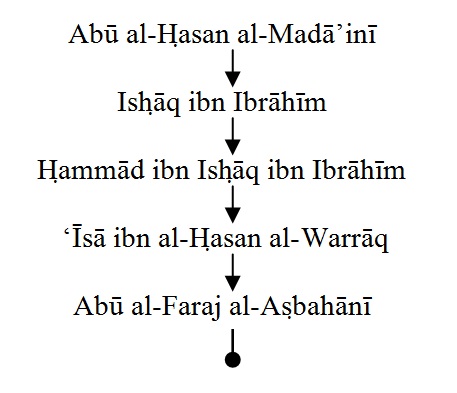
Following is
the jarh on some of its narrators:
a. ‘Īsā ibn al-Hasan al-Warrāq
No tawthīq is available on him in rijāl books. Hence, he is
majhūl al-hāl.
b. Hammad ibn
Ishāq ibn Ibrāhīm al-Mūsilī
No tawthīq is available on him in rijāl books. Hence, he is
majhūl al-hāl.
c. Abū al-Hasan
‘Alī ibn Muhammad ibn ‘Abdullāh al-Madā’inī
Ibn Adī says
that he is laysa bi al-qawī fī al-hadīth.
iii. Muhammad
ibn ‘Ubaydullāh ibn ‘Amr al-‘Utbī
(d. 228 AH)
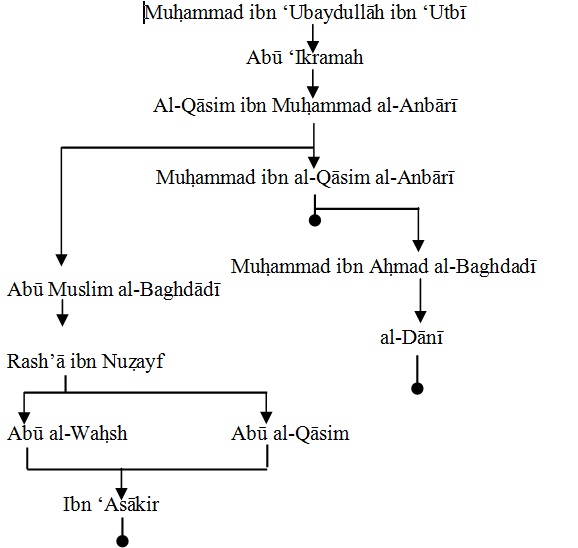
Following is
the jarh on some of its narrators:
a. Abū ‘Ikramah
‘Amir ibn ‘Imrān ibn Ziyād al-Dabbī
No tawthīq is available on him in rijāl books. Hence, he is
majhūl al-hāl.
b. Muhammad ibn ‘Ubaydullāh ibn ‘Amr al-‘Utbī
Ibn Qutaybah, al-Safadī and Ibn Khallikān record the following
jarh on him: kāna mushtahiran bi al-sharāb.
On a similar note, al-Dhahabī records: kāna
yashribu.
iv. Muhammad ibn Yazīd al-Mubarrad (d. 286
AH)
This has no chain of narration. Al-Dānī cites him in his Al-Muhkam.
As far as the reports are concerned which say that the first
person to put nuqat on the masāhif was Abū al-Aswad, the first
person to narrate such a report is al-Zubaydi (d. 379 AH) in
his Tabaqāt with reference to al-Mubarrad (d. 286 AH). The
inqitā‘ here is obvious too!
4. The accounts of Al-Mada’ini (d. 225 AH) and ‘Utbī (228 AH)
cited earlier mention that Abū al-Aswad was induced to put
nuqat on the masāhif when he heard someone wrongly reading a
verse of Sūrah Tawbah. On the other hand, it is reported by
‘Abbād ibn ‘Abbād ibn Habīb al-Mahallab
(d. 181 AH) that when Abū al-Aswad heard someone wrongly
reading the masāhif, he resolved to institute grammar (not
nuqat). Furthermore, there is yet another report by Ibn Abī
Malaykah (d. 117 AH) (see point 9 ahead) which says that it
was this very verse of Sūrah Tawbah which was wrongly taught
to and read by a Beduoin. When ‘Umar heard of this, he asked
Abū al-Aswad to institute the rules of grammar (again no
mention of nuqat).
So it is strange that the same verse of Sūrah Tawbah occurs:
i. at times to induce Abū al-Aswad to institute grammar and at
times to institute the nuqat.
ii. at times in an incident in the time of ‘Umar (rta) and at
times in the times of Mu‘āwiyah (rta) to induce its listener
to two different acts.
‘Abbād’s report may be illustrated thus:
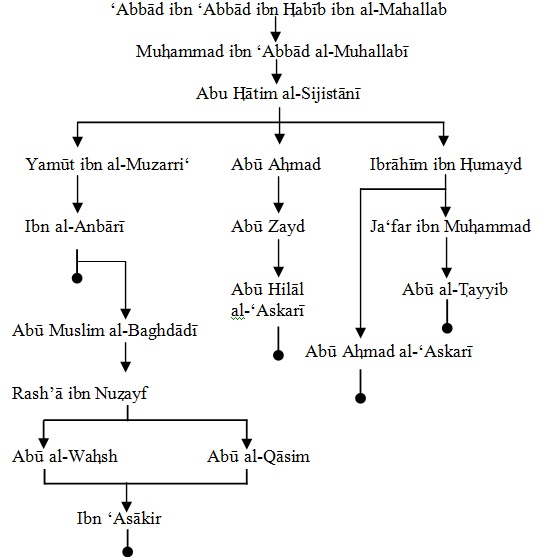
a. ‘Abbād ibn ‘Abbād ibn Habīb ibn al-Mahallab
Al-Mizzī
records that in the opinion of Abū Hātim, he is lā yuhtajju bi
hadīthihī. Though at one place Ibn Sa‘d states: thiqah wa
rubbama ghalita,
at another place, his words about him are: lam yakun bi al-qawī
fī al-hadīth.
Ibn Hajar
says about him: thiqah rubbamā wahima.
b. Muhammad ibn ‘Abbād al-Muhallabī
Al-Khatīb al-Baghdādī records:
lam yakun basīran bi al-hadīth (he is not
intelligent in matters of hadīth) and according to al-Harbī is
guilty of misspelling words (tashīf); he altered
بقرة to
بهرة and
ابن جابر to
ابن جدير.
It is perhaps because of this that Abū Hātim’s opinion about
him is: lam aktub ‘anhū shay’
(I have not written anything from him).
It may thus be observed that the report of ‘Abbād (d. 181 AH)
has problems in its chain of narration. However, since the
reports of Ibn Abī Malaykah
(d. 117 AH), al-Madā’īnī (d. 225 AH) and al-‘Utbī (d. 228 AH)
themselves suffer from flaws in their chains of narration
hence it was deemed appropriate to compare the four with one
another.
5. An interesting point to note in Mubarrad’s account (as
opposed to the rest of the three) is that Abū al-Aswad set
about instituting the rules of grammar by putting nuqat on the
masāhif: apparently the two have no connection. This act
obviously could only safeguard correctly reading the masāhif
and not in helping people learn Arabic grammar.
6. The first book in which Abū al-Aswad’s nuqat accounts
are recorded is Al-Waqf wa al-Ibtidā’ by Ibn al-Anbārī (d. 328
AH). However, at least five major works prior to Al-Waqf wa
al-Ibtidā’ which record biographical entries on Abū al-Aswad
are devoid of any nuqat mention. The question arises: Why?
Here are the details:
i. Al-Tabaqāt by Ibn Sa‘d (d. 230 AH)
Ibn Sa‘d gives a short biographical entry on Abū al-Aswad in
which says that he was a poet and became the governor of
Basrah. Similarly, it also contains a note on Ziyād ibn Abīh;
but these entries are devoid of any mention of Abū al-Aswad
inserting nuqat.
ii. Tabaqāt fuhūl al-shu‘arā’ by Muhammad ibn Salām al-Jumahī
(d. 232 AH)
Al-Jumahī gives a short biographical entry on Abū al-Aswad
which says that he was the first to institute the rules of
Arabic but does not mention anything about his role in nuqat.
iii. Ma‘rifah al-Thiqāt by al-‘Ijlī (d. 261 AH)
He records that Abū al-Aswad is from among the prominent
tābi‘ūn, a companion of ‘Alī (rta) and a person who was the
first to talk about about nahw. However, he records nothing on
his contribution to nuqat.
iv. Al-Ma‘ārif by Ibn Qutaybah (276 AH)
Ibn Qutaybah gives a short biographical entry on Abū al-Aswad
which says that he was a poet, was the first to formulate the
rules of Arabic and became the governor of Basrah but does not
mention that he had any role in introducing nuqat on the
masāhif.
v. Al-jarh wa al-ta‘dīl by Ibn Abī Hātim (d. 327 AH)
Ibn Abī Hātim gives a short biographical entry on Abū al-Aswad
in which he records his real name (Zālim ibn ‘Amr), states
that he is a reliable narrator and is also the first who
formulated nahw. The entry is devoid of any mention of his
feat of inserting nuqat on the masāhif.
It is from the first quarter of the fourth century onwards
that we find books recording accounts which attribute
introduction of nuqat on the masāhif by Abū al-Aswad. These
works include: Marātib al-nahwiyyīn
by Abū al-Tayyib (d. 351 AH), Kitāb al-Aghānī
by Abū al-Faraj (d. 356 AH), Akhbār Al-nahwiyyīn
by al-Sayrāfī (d. 368 AH), Tabaqāt al-nahwiyyīn
by al-Zubaydī (d. 379 AH), Fihrist
by Ibn Nadīm (d. 385 AH), Al-Muhkam
by al-Dānī (d. 444 AH), Tārīkh Madīnah Dimashq
by Ibn ‘Asākir (d. 571 AH), Nuzhat al-alibbā’
by Ibn al-Anbārī (d. 577 AH), Inbā’ al-ruwāt
by al-Qiftī (d. 624 AH).
In this regard, perhaps the first historian to say that Abū
al-Aswad was the first person nuqat on the masāhif is Ibn
al-Jawzī
(d. 597 AH) and he does not mention various accounts which
record Abū al-Aswad’s endeavour. He merely records that Abū
al-Aswad was the first to put nuqat on the masāhif. Similar
statements are recorded by Yāqūt al-Hamawī
(626 AH), al-Safadī (764 AH)
and al-Dhahabī
(d. 748 AH).
However, there are works even after the first quarter of
the fourth century right up to the ninth century which mention
biographical information about Abū al-Aswad but do not state
that he had any role in recording nuqat on the masāhif. These
include:
i. Al-Thiqāt by Ibn Hibbān (d. 354 AH)
Ibn Hibbān does record that Abū al-Aswad took part in the
battle of Siffīn, was deputed as a governor of Basrah and was
the first to institute nahw.
ii. Al-Ta‘dīl wa al-tajrīh
by al-Bājī
(d. 464 AH)
Al-Bājī records various opinions about his name, that he
was the first to institute nahw, was a reliable a narrator and
died in the plague of 69 AH.
iii. Usud al-Ghābah by Ibn Athīr (d. 630 AH)
Ibn Athīr does record that Abū al-Aswad was not able to
acquire the companionship of the Prophet (sws), was a famous
tābi‘ī, was companion of ‘Alī (rta) who made him the governor
of Basah and was the first to institute nahw, was a poet and a
profound literary figure.
iv. Al-Bidāyah wa al-nihāyah by Ibn Kathīr (d. 772 AH)
Ibn Kathīr gives a short biographical entry on Abū al-Aswad
which among other details says that he was the first to
formulate the rules of Arabic.
v. Tārīkh of Ibn Khaldūn (d. 808 AH)
Ibn Khaldūn mentions the fact that Abū al-Aswad was the first
person to formulate Arabic grammar.
All this data cast serious doubts on this alleged role
ascribed to Abū al-Aswad.
7. In this regard, it may be noted that the strangest omission
of Abū al-Aswad’s endeavour is in the Kitāb al-masāhif
of Ibn Abī Dā’ūd (d. 316 AH).
The whole book has copious information about directives and
issues related to the masāhif. It has a section on nuqat
al-maāhif which is rich in information on the subject. It has a
narrative which says that the first person to put nuqat on the
masāhif was Yahyā ibn Ya‘mar;
it mentions narratives which record the names of early
authorities who disliked putting nuqat on the mushaf and
others who did not see any harm in it;
it mentions a narrative which records the opinion of al-Hasan
al-Basrī that charging money for putting nuqat on masāhif was
not a problem;
it records a detailed narrative on the authority of Abū Hatim
Sijistanī on the methodology of putting nuqat on masāhif.
The initial part of the narrative even describes the same
scheme as that of Abū al-Aswad but without taking his name. It
is quite strange that in the wake of all these details, there
is no mention of Abū al-Aswad and his endeavour.
8. The accounts of Al-Madā’inī (d. 225 AH) and ‘Utbī (228
AH) cited earlier in detail mention that it was at the behest
of Ziyād ibn Abīh (d. 53 AH), the governor of Basrah that Abū
al-Aswad undertook this job.
Accounts of Ziyād (who is also called Ziyād ibn Abī Sufyān,
Ziyād ibn Sumayyah, Ziyād ibn Amah and Ziyād ibn ‘Ubayd)
are mentioned in various books of Muslim history. None of the
following books which contain biographical accounts of Ziyād
even alludes to the fact that he had any role in this task:
i. Al-Tabaqāt
by Ibn Sa‘d (d. 230 AH)
ii. Al-Ma‘ārif
by Ibn Qutaybah (d. 276 AH)
iii. Al-Akhbār al-tiwāl
by al-Dīnwarī (d. 282 AH)
iv. Al-Istī‘āb
by Ibn ‘Abd al-Barr (d. 463 AH)
v. Tārīkh Madīnah Dimashq
by Ibn ‘Asākir (d. 571 AH)
vi. Al-Muntazim
Ibn al-Jawzī (597 AH)
vii. Al-Kāmil fī al-tārīkh
by Ibn Athīr (d. 630 AH)
viii. Siyar a‘lām al-nubalā’
by al-Dhahabī (d. 748 AH)
ix. Fawāt al-Wafayāt
by Muhammad ibn Shākir al-Kutbī (d. 764 AH)
x. Al-Wāfī bi al-wafayāt
by al-Safadī (764 AH)
xi. Al-Bidāyah wa al-nihāyah
by Ibn Kathīr (d. 772 AH)
xii. Al-Isābah
by Ibn Hajar (d. 852 AH)
xiii. Lisān al-mīzān
by Ibn Hajar (d. 852 AH)
xiv. Majma‘ al-bahrayn
by Shaykh al-Tarīhī (d. 1085 AH)
xv. A‘yān al-shī‘ah
by Sayyid Muhsin al-Amīn (d. 1371 AH)
xvi. Al-A‘lām
by al-Zarkalī (d. 1396 AH)
9. All of the chains of narration of the accounts cited under
points 2 and 3 hinge on a final Basran narrator. Is this a
mere co-incidence or does this smell of Basran bias over their
rival Kufans? There is not a single Kufan grammarian or
personality who reports that Abū al-Aswad was responsible of
putting nuqat on the masāhif. Why is this so?
In contrast to what is attributed to Abū al-Aswad al-Dū’alī’s
endeavour in putting i‘rāb on the Qur’ān, it may be noted that
sources also record on the authority of ‘Abdullāh ibn
‘Ubaydullāh ibn Abī Malaykah (d. 117 AH) with reference to
this same incident that it was at the behest of ‘Umar (rta)
that Abū al-Aswad had constituted the rules of Arabic grammar.
As per this report
a Bedouin came over to Madīnah in the reign of ‘Umar (rta) and
asked for someone who could teach him what was revealed to
Muhammad (sws). It is reported that a person taught him Sūrah
Tawbah and he read the following verse by altering the
vocalization of the last word: أَنَّ اللّهَ
بَرِيءٌ مِّنَ الْمُشْرِكِينَ وَرَسُولُهُ. He read the
last word as: رَسُولِهِ. At this the
Bedouin said: “Is God acquitted of His Messenger; if he is
acquitted of His Messenger, then I am more acquitted of the
Messenger of God.” These words of the Bedouin reached ‘Umar (rta),
who called him over and said: “Are you acquitted of the
Messenger of God.” The Bedouin replied that he came over to
Madīnah and did not have any knowledge of the Qur’ān and had
asked for someone to teach him the Qur’ān; the Bedouin
continued that a person taught him Sūrah Tawbah and read:
رَسُولِهِ أَنَّ اللّهَ بَرِيءٌ مِّنَ
الْمُشْرِكِينَ وَ; at this, he had said whether is God
acquitted of His Messenger; if he is acquitted of His
Messenger, then he [the Bedouin] is more acquitted of the
Messenger of God. At this, ‘Umar told the Bedouin that this is
not so; the Bedouin then promptly asked for an explanation.
‘Umar then read the verse as:أَنَّ اللّهَ
بَرِيءٌ مِّنَ الْمُشْرِكِينَ وَرَسُولُهُ. The Bedouin
swore by God and said that he is acquitted of those of whom
God and His Messenger are acquitted. ‘Umar then ordered that
no one except a person who has knowledge of Arabic should
teach the Qur’ān and directed Abū al-Aswad to formulate nahw
which he did so.
If the above report is true, then it can be surmised that
it had nothing to do with putting nuqat on the mushaf; it only
impelled ‘Umar (rta) to ask Abū al-Aswad to formulate the
rules of Arabic Grammar.
It may be noted that most narrators of this report are non-Basran.
Details follow:
i. Abū Bakr Muhammad ibn al-Qāsim ibn Muhammad ibn Bashshār
al-Anbārī (d. 328 AH) (born in Anbār and died in Baghdād).
ii. Muhammad ibn Yahyā ibn Abī Hazm Mihrān (d. 253 AH)
(belonged to Basrah)
iii. Abū Bakr Muhammad ibn ‘Īsā ibn Yazīd (d. 277 AH)
(belonged to Balkh).
iv. Abū Tawbah al-Rabī‘ ibn Nāfi‘ (d. 241 AH) (belonged to
Tarsūs).
v. ‘Īsā ibn Yūnus ibn ‘Amr al-Sabī‘ī (d. 287 AH) (belonged
to Kufah).
vi. ‘Abū al-Walīd Abd al-Malik ibn ‘Abd al-‘Azīz ibn Jurayj
(d. 150 AH) (belonged to Makkah).
vii. Abū Bakr ‘Abdullāh ibn ‘Ubaydullāh ibn Abī Malaykah
(d. 117 AH) (belonged to Makkah).
It may however be argued that there are weaknesses in this
report:
i. Ibn al-Anbārī has not specified his teacher. His words
are: “one of our companions said …(قال بعض
أصحابنا).
ii. ‘Abd al-Malik ibn ‘Abd al-‘Azīz ibn Jurayj is a
mudallis.
iii. Muhammad ibn ‘Īsā ibn Yazīd is also suspect. Ibn
Hibbān says that he errs a lot (yukhtī kathīr).
Ibn ‘Adī says that he steals hadīth (yasriqu al-hadīth).
10. Hamzah ibn al-Hasan al-Asbahānī (d. 360 AH)
and Abū Ahmad al-‘Askarī (d. 380 AH)
who are the first to record the diacrtics phase on the masāhif
clearly negate that Abū al-Aswad put nuqat on the Qur’ān. This
is shown by the silence of these texts about any endeavour by
Abū al-Aswad whereas the way they mention the masāhif after
the period of ‘Uthmān (rta) entails that had Abū al-Aswad done
anything to the effect, it should have found its mention here.
Abū Ahmad al-‘Askarī’s text reads:
وقد رُوى أنّ السبب في نَقْط المصاحف أن
الناس غَبَرُوا يقرءون فى مصاحف عثمان رحمة الله عليه ، نيِّفا
وأربعين سنة ، إلى أيام عبد الملك بن مروان. ثم كثر التصحيف
وانتشر بالعراق ، ففزِع الحجاَّجُ إلي كُتَّابه ، وسألهم أن
يضعوا لهذه لحروف المشْتَبِهةِ علامات. فيقال : إنّ نصرِ بن عاصم
قام بذلك ، فوضع لنَّقط أفرادا و أزواجا. وخالف بين أما كنها
بتوقيع بعضها فوق الحروف ، وبعضها نحت الحروف فَغَبَر الناس بذلك
زمانا لا يكتبون إلا منقوطا. فكان مع استعمال النقط أيضا يقع
التصحيف ، فأحدثوا الإعْجام ، فكانوا يُتْبِعون النَّقط
بالإعجام. فإذا أُغْفِل الاستقصاءُ على الكلمة فلم تُوَفَّ
حقوقَها اعترى هذا التصحيفُ ، فالتمسوا حيلةً ، فلم يقْدِروا
فيها إلا على الأخذ من أفواهِ الرجال.
It is
narrated that the reason to put nuqat on the masāhif was that
people continued to read the masāhif of ‘Uthmān (rta) for
almost forty years until [the era of] ‘Abd al-Malik ibn Marwān
arrived. Then misreading (tashīf) of the script [of the Qur’ān]
became rampant and spread in ‘Irāq. So al-Hajjāj anxiously
turned to his scribes and asked him to devise signs for these
similar letters. It is said that Nasr ibn ‘Āsim took this
responsibility and he devised dots ones and twos and placed
them differently on them by putting some on the top and some
on the bottom of these hurūf. People stuck [to this method of
Nasr] for many years and would not write [masāhif] without
nuqat. But even after using nuqat, misreading [of the masāhif]
continued. So they invented i‘jām and used i‘jām with nuqat as
well. A slight carelessness in putting in all i‘jām with nuqat
on words again resulted in tashīf. People looked for a further
method [to secure the correct reading] but were not able to
find one except for acquiring [the Qur’ān] from the mouths of
people.
B. The Diacritics Phase
The following questions arise on the traditional account viz a
viz this phase.
1. The ascription of the insertion of diacritics to Nasr
ibn ‘Āsim is suspect. The text
of Hamzah ibn al-Hasan al-Asbahānī (d. 360 AH), which is the
first text to explicitly say that a lack of diacritics caused
tashīf after which these diacritics were inserted does not
even mention Nasr’s name as the one deputed to this task. The
text
of Abū Ahmad al-‘Askarī (d. 382 AH) which is chronologically
the second text that explicitly says that a lack of diacritics
caused tashīf also weakly mentions Nasr’s name (the word used
is: yuqāl).
Thus none of Nasr’s students narrate this feat from him.
Al-Mizzī
has recorded the following names of his students: Bishr ibn
‘Ubayd (d. ?), Abū Sha‘thā’ Jābir ibn Zayd (d. 93 AH), Humayd
ibn Hilāl, ‘Imrān ibn Hudayr (d. 147 AH), Qatādah ibn Di‘āmah
(d. 118 AH), Mālik ibn Dīnār (d. 123 AH), Abū Sa‘d Sa‘īd ibn
al-Mirzabān al-Baqqāl (d. 140 AH approx), Abū Salamah (d. ?).
The first person to say that Nasr ibn ‘Āsim was the first
to put nuqat is Abū Hātim al-Sijistānī (d. 250 AH) as recorded
by al-Dānī.
So it is after almost two centuries that this primacy is
ascribed to him. None of Nasr’s students, as pointed out
earlier, or any one from his immediate generations has ever
reported to have said this. It can also be said with
reasonable certainty that in the first six centuries, al-Dānī
is the only person to ascribe nuqāt to Nasr. Even this primacy
of nuqat ascribed to Nasr by al-Dānī is rendered weak because
many books which mention biographical notes on Nasr are devoid
of ascribing this accomplishment to him. They include:
i. Akhbār al-nahwiyyīn al-basriyyīn
by al-Sayrāfī (d. 368
AH)
Al-Sayrāfī records on the authority of
Khālid al-Hadhdhā’ (d. 141 AH) that ‘Āsim was the first to
formulate [the principles of] Arabic.
ii. Tabaqāt al-nahwiyyīn wa lughwiyyīn
by al-Zubaydī (d. 379 AH)
Al-Zubaydī too records on the authority of
Khālid al-Hadhdhā’ (d. 141 AH) that Nasr ibn ‘Āsim
was the first to formulate [the principles of]
Arabic.
iii.
Nuzhah
al-alibbā’ by Abū al-Barkāt ibn al-Anbārī
(d. 577 AH)
Abū al-Barkāt records that Nasr ibn
‘Āsim is a jurist, a scholar of Arabic and
teacher of grammar and qirā’ah.
iv. Inbā’ al-ruwāt
by al-Qiftī (d. 624 AH)
Al-Qiftī mentions that Nasr is among the
earlierst scholars of Arabic grammar and a jurist. He also
records the report from Khālid al-Hadhdhā’ (d. 141 AH) that
Nasr ibn ‘Āsim was the first to
formulate Arabic.
v. Mu‘jam al-udabā’ by Yāqūt al-Hamawī (626 AH)
Among other minor details, Yāqūt records that Nasr was a
jurist, a scholar of Arabic and acquired the Qur’ān and nahw
from Abū al-Aswad; he initially had the same views as the
Kharijites but later abandoned them; he died in 89 AH.
vi. Tahdhīb al-kamāl
by al-Mizzī (d. 742
AH)
Al-Mizzī cites the opinion of Khalīfah ibn al-Khayyāt that
Nasr belonged to the second tabqah of the reciters of Basrah
and that as per an opinion he was the first to institute nahw.
vii. Al-Wāfī bi al-wafayāt by al-Safadī (764 AH)
Al-Safadī records almost the same information as Yāqūt
above and adds that in the opinion of Abū Dā’ūd al-Sijistānī
he was the first to formulate nahw.
viii. Tahdhīb al-tahdhīb
by Ibn
Hajar (d. 852 AH)
Ibn Hajar cites the opinion of Khalīfah ibn al-Khayyāt that
Nasr belonged to the second tabqah of the reciters of Basrah.
ix. Bughyah al-wu‘āt by al-Suyūtī (d. 911 AH)
Al-Suyūtī merely records the opinion of Yāqūt al-Hamawī
cited above.
As mentioned earlier, the above referred to books
not only do not accord any primacy of nuqat to him, they do
not even mention that Nasr had any role in this matter. This
is indeed quite strange that these biographical works on his
personality have nothing to record about him about this
alleged endeavour.
2. The first explicit ascription of Yahyā ibn Ya‘mar to the
insertion of diacritical dots to distinguish similar letters
is also suspect. The first person to mention his name is Ibn
Atiyah (d. 543 AH):
وأما شكل المصحف ونقطه فروي أن عبد الملك بن
مروان أمر به وعمله فتجرد لذلك الحجاج بواسط وجد فيه وزاد تحزيبه
وأمر وهو والي العراق الحسن ويحيى بن يعمر بذلك
As far as
the shakl and nuqat of the masāhif are concerned, it is
reported that ‘Abd al-Malik ordered for it and had it done. He
specifically deputed al-Hajjāj for this task in [the city of]
Wāsit. Al-Hajjāj expended his effort in this task and also
added divisions to the mushaf. It was while he was the
governor of Iraq that he ordered al-Hasan al-Basrī and Yahyā
ibn Ya‘mar to do this.
In other words, it is almost five centuries after the death
of Yahyā that someone has explicitly taken his name and
ascribed this endeavour to him. Moreover this report in itself
suffers from the flaw that it contradicts other reports which
say that nuqat and shakl were carried out by different
personalities. It is linguistically not possible to ascribe
the same meaning to both these words and to interpret both to
mean diacritical dots.
As far as the report that Yahyā was the first to put nuqat
on the mushaf is concerned, its earliest ascription is to
Hārūn ibn Mūsā (d. before 200 AH).
However, none of Yahyā ibn Ya‘mar’s students report this
endeavour from him. His students recorded by al-Mizzī are:
al-Azraq ibn Qays (d. after 120 AH), Ishāq ibn Suwayd (d. 131
AH), Abū Sa‘īd Thābit (d. ?), Habīb ibn ‘Atā’ (d. ?), al-Rukayn
ibn Rabī‘ (d. 131 AH), Sulaymān ibn Buraydah (d. 105 AH),
Sulaymān al-Taymī (d. 143 AH), ‘Abdullāh ibn Buraydah (d. 115
AH), ‘Abdullāh ibn Qutbah (d. ?), ‘Abdullāh ibn Kulayb (d. ?),
Abū al-Munīb ‘Ubaydullāh ibn ‘Abdullāh (?), ‘Atā al-Khurasānī
(d. 135 AH), ‘Ikramah mawlā Ibn ‘Abbās (d. 107 AH), ‘Umar ibn
‘Atā’ ibn Abī al-Khawwār (d. ?), Qatādah ibn Di‘āmah (d 117
AH) and Yahyā ibn Abī Ishāq al-Hadramī (d. 136 AH).
Even this primacy ascribed to Yahyā by Hārūn ibn Mūsā (d.
before 200 AH) is weakened due to the fact that many books
which mention biographical notes on Yahyā are devoid of
ascribing this accomplishment to him. They include:
i. Al-Tabaqāt al-kubrā by Ibn Sa‘d (d. 230 AH)
Ibn Sa‘d records that Yahyā was a
grammarian and scholar of Arabic and the Qur’ān.
ii. Marātib al-nahwiyyīn
by Abū al-Tayyib
‘Abd al-Wāhid (d. 351 AH)
Abū al-Tayyib records the statement of
Qatādah that the first person to formulate the rules of Arabic
grammar after Abū al-Aswad was Yahyā ibn Ya‘mar.
iii. Mashāhīr ‘ulamā al-amsār by Ibn Hibbān (d. 354 AH)
Ibn Hibbān says that Yahyā was a
qādī of Marw and from among the most eloquent people of his
times, a very profound scholar of Arabic and a pious person.
iv. Akhbār al-nahwiyyīn al-basriyyīn
by
al-Sayrāfī (d. 368 AH)
Al-Sayrāfī records that Yahyā added
chapters to the book of arabic grammar forumulated by Abū
al-Aswad. He also records a dialogue of his with al-Hajjāj
involving lahn.
iv. Tabaqāt al-nahwiyyīn wa lughwiyyīn by
al-Zubaydī (d. 379 AH)
Al-Zubaydī records that Yahyā learnt
Arabic grammar from Abū al-Aswad. He also records on the
authority of Khālid al-Hadhdhā’ that Ibn Sīrīn had a manqūt
mushaf on which nuqat were put by Yahyā.
v. Nuzhah al-alibbā’
by Abū al-Barkāt ibn
al-Anbārī (d. 577 AH)
Abū al-Barkāt records that Yahyā was
a scholar of Arabic and Hadīth, and would use a lot of gharīb
words in his works. He also records his dialogue with
al-Hajjāj involving lahn.
vi. Al-Muntazim
by Ibn al-Jawzī (d. 597 AH)
Ibn al-Jawzī records that Yahyā was
a scholar of Arabic and the Qur’ān.
vii. Inbā’ al-ruwāt
by al-Qiftī (d. 624 AH)
Al-Qiftī records many of the details
already alluded to by his predecessors. He mentions that he
was one of the qurrā’ of Basrah. He was a qādī of
Marw and was
a scholar of the Qur’ān, Arabic grammar and the dialects of
the Arabs. He had an argument with al-Hajjāj regarding an
issue relating to lahn.
viii. Mu‘jam
al-udabā’ by Yāqūt al-Hamawī
(d. 626 AH)
Yāqūt mentions that Yahyā was a scholar of
qirā’ah, Hadīth, Fiqh, Arabic and dialects of Arabia.
ix. Wafayāt al-a‘yān
by Ibn Khallikān (d.
681 AH)
Ibn Khallikān mentions that Yahyā was a
scholar of the Qur’ān, Arabic grammar and the dialects of
Arabia, and that he had learnt Arabic grammar from Abū
al-Aswad. He also records a dialogue of his with al-Hajjāj
involving lahn.
x. Bughyah al-wu‘āt
by
al-Suyūtī (d. 911 AH)
Al-Suyūtī records that Yahya learnt
Arabic grammar from Abū al-Aswad and was appointed the qādī of
Khurasan by Qutaybah ibn Muslim.
The above referred to books not only do not accord any
primacy of nuqat to him, they do not even mention that Yahyā
had any role in inseting nuqat on the masāhif or that Yahyā
was summoned by al-Hajjāj for this purpose even though as
referred to earlier some of them record a dialogue between
Yahyā and al-Hajjāj about lahn.
This is indeed quite strange that such early biographical
works on his personality have nothing to record about him
about this alleged endeavour.
3. Ibn Atiyah (d. 543 AH),
al-Qurtubī (d. 671 AH),182
Ibn al-Jazzī Kalbī (d. 757 AH)
and Ibn Kathīr (d. 774 AH)
mention that al-Hajjāj had deputed al-Hasan al-Basrī (d. 110
AH) as well for putting nuqat on the masāhif together with
Yahyā ibn Ya‘mar.
The following books contain biographical accounts of al-Hasan
ibn al-Hasan al-Basrī but do not mention that he had any role
in putting nuqat on the masāhif.
i. Al-Tabaqāt
by Ibn Sa‘d (d. 230 AH)
ii. Al-Tārīkh al-Kabīr
by al-Bukhārī d. (256 AH)
iii. Tārīkh Wāsit
by Aslam ibn Sahl al-Wāsitī (d. 264 AH)
iv. Al-Ma‘ārif
by Ibn Qutaybah (d. 276 AH)
v. Al-Ma‘rifah wa al-tārīkh
by al-Fasawī (d. 277 AH)
vi. Akhbār al-qudāt
by Muhammad ibn Khalaf ibn Hayyān (d. 306 AH)
vii. Al-Muntazim
by Ibn al-Jawzī (d. 597 AH)
viii. Wafayāt al-a‘yan
by Ibn Khallikān (d. 681 AH)
ix. Tahdhīb al-kamāl
by al-Mizzī (d. 743 AH)
x. Siyar a‘lām al-nubalā’
by al-Dhahabī (d. 748 AH)
xi. Al-Wāfī bi al-wafayāt
by al-Safadī (764 AH)
It may be of further interest to note contradictory reports
ascribed to al-Hasan: some say that al-Hasan approved of
putting nuqat on the masāhif, while others report the
opposite.
4. Hamzah ibn al-Hasan al-Asbahānī (d. 360 AH)
and Abū Ahmad al-‘Askarī (d. 380 AH)
who are the earliest to record the diacritics phase mention
that it was al-Hajjāj who was primarily responsible for
carrying out the remedial measures for stopping tashīf.
Similarly, Ibn Atiyah (d. 543 AH),
al-Qurtubī (d. 671 AH),
Ibn al-Jazzī Kalbī (d. 757 AH)
and Ibn Kathīr (d. 774 AH)
also mention al-Hajjāj was deputed for this task and further
mention that ‘Abd al-Malik ibn Marwān, the then caliph of the
Muslims deputed him for this purpose. They say that he had
asked al-Hajjāj to put nuqat and shakl on the masāhif.
Now it is known that both al-Hajjāj ibn Yūsuf and ‘Abd al-Malik
ibn Marwān are two celebrated personalities of the Umayyad
caliphate. Their achievements and feats have been recorded in
detail by all historians. It is quite strange that a vast
majority of historians do not record any such achievement by
either of them.
Following is a brief survey of both these personalities in
early and medieval history works:
I ‘Abd al-Malik ibn Marwān
i. Al-Tabaqāt
by Ibn Sa‘d (d. 230 AH)
ii. Al-Tārīkh al-Kabīr
by al-Bukhārī d. (256 AH)
iii. Tārīkh Wāsit
by Aslam ibn Sahl al-Wāsitī (d. 264 AH)
iv. Al-Ma‘ārif.
by Ibn Qutaybah (276 AH)
v. Tārīkh
by al-Ya‘qūbī (d. 292 AH)
vi. Al-‘Iqd al-farīd
by Ibn ‘Abd Rabbih (d. 328 AH)
vii. Kitāb al-wuzarā wa al-kuttāb
by Al-Jahshiyarī (d. 331AH)
viii. Al-Bad’ wa al-tārīkh
by al-Maqdisī (d. 355 AH)
ix. Tārīkh Baghdād
by al-Khatīb al-Baghdādī (d. 463 AH)
x. Tārīkh Madīnah Dimashq
by Ibn ‘Asākir (d. 571 AH)
xi. Al-Muntazim
by Ibn al-Jawzī (d. 597 AH)
xii. Tahdhīb al-kamāl
by al-Mizzī (d. 742 AH)
xiii. Siyar a‘lām al-nubalā’
by al-Dhahabī (d. 748 AH)
xiv. Al-Wāfī bi al-wafayāt
by al-Safadī (764 AH)
xv. Al-Bidāyah wa al-nihāyah
by Ibn Kathīr (d. 772 AH)
xvi. Tahdhīb al-tahdhīb
by Ibn Hajar (d. 852 AH)
II Al-Hajjāj ibn Yūsuf al-Thaqafī
i. Tārīkh Wāsit
by Aslam ibn Sahl al-Wāsitī (d. 264 AH)
ii. Al-Ma‘ārif
by Ibn Qutaybah (276 AH)
iii. Kitāb al-wuzarā wa al-kuttāb
by Al-Jahshiyarī (d. 331AH)
iv. Al-Bad’ wa al-tārīkh
by by al-Maqdisī (d. 355 AH)
v. Tārīkh Madīnah Dimashq
by Ibn ‘Asākir (d. 571 AH)
vi. Al-Muntazim
by Ibn al-Jawzī (d. 597 AH)
vii. Al-Kāmil fī al-tārīkh
by Ibn Athīr (d. 630 AH)
viii. Tahdhīb al-kamāl.
by al-Mizzī (d. 742 AH)
It may be noted that perhaps the first historian to say that
al-Hajjāj was responsible for this endavour is Ibn Khallikān
(d. 681 AH).
However, his source is the text of Abū Ahmad al-‘Askarī
already referred to above. Similarly, al-Safadī (764 AH)
also refers to this on the basis of Abū Ahmad al-‘Askarī. Ibn
Kathīr (d. 772 AH)
does say that during the days of al-Hajjāj, the nuqat were put
on the masāhif and does not mention any source of this
statement.
5. The texts of Hamzah ibn al-Hasan al-Asbahānī (d. 360 AH)
and Abū Ahmad al-‘Askarī (d. 380 AH)
say that Nasr ibn ‘Āsim was the originator of diacritics on
similar letters. This contradicts the following information.
Ibn ‘Abbās is reported to have said:
أول من كتب بالعربية ثلاثة رجال من بولان
وهي قبيلة سكنوا الأنبار
وأنهم اجتمعوا فوضعوا حروفا مقطعة
وموصولة وهم مرار بن مرة وأسلم بن سدرة وعامر بن جدرة ويقال مروة
وجدلة فأما مرامر فوضع الصور وأما أسلم ففصل ووصل وأما عامر فوضع
الإعجام
The first
ones to write Arabic were three men from Būlān which is a
tribe that lived at al-Anbār; they got together and coined the
letters – both in their connected and disconnected forms.
These three were: Marāmir ibn Murrah, Aslām ibn Sidrah and
‘Āmir ibn Jadrah (also: Marwah / Jadalah). As for Marāmir, he
conceived the forms (suwar)) of the letters, Aslam their
separations and linkages (fasl and wasl) while ‘Āmir invented
the diacritics (i‘jām).
Al-Qalqashandī
says that the diacritics were invented at the time of the
letters because it is very unlikely that letters which
resemble one another should be devoid of them. Al-Kurdī,
Jumu‘ah
and Hifnī
also say that they were invented at the time of the letters
themselves. Salāh al-Dīn Munajjid
and ‘Abd al-Sabūr Shahīn
surmise that it was not that Nasr and Yahyā originated them
because their existence is found in earlier writings.
Thus the earliest dated Arabic document (recently
re-deciphered by Healy and Smith) corresponding to 267 AD
shows dots on dhāl, rā and shīn.
‘Alī ibn Ibrāhīm Ghabbān in an article (translated from
Arabic by Robert Hoyland) has given tracings of the following
writings which depict the use of diacritical dots on various
letters in the first century.
Among them, the following are clearly well before the time
dots were allegedly invented by Nasr.
i. Papyrus of Ahnus housed in Vienna National Library (22 AH).
Diacritical dots appear on the letters: sha, za, dha, kha, ja
and na.
ii. Zuhayr inscription in Saudi Arabia (24 AH). Diacritical
dots appear on the letters: nūn (on three occasions), za (on
two occasions), dha, ta, fa and sha.
iii. Al-Khanaq dam inscription near Madīnah (40-60 AH). A
diacritical dot appears on the letter ta.
iv. Wadi Sabil inscription near Najran (46 AH). A diacritical
dot appears on the letter ba.
v. Mu‘āwiyah dam inscription near Tā’if (58 AH). Diacritical
dots appear on the letters: ba (on four occasions), na (on
four occasions), ya (on four occasions), tha (on two
occasions), ta (on two occasions)
Mirza,
in a recent PhD dissertation has shown the existence of a
diacritical dot on the letter na (occurring twice) in the
Prophet’s letter (6 / 8 AH) to al-Mundhir ibn al-Sāwā,
governor of Bahrayn. As such, this is perhaps the earliest
occurrence of a diacritical dot on documents discovered so
far.
Gruendler has also pointed out many early texts which have
diacritical dots. The following are clearly before the period
of the alleged invention of diacritics by Nasr:
i. Entagion (P. Colt no 60). This consists of thirteen papyri
and most of them are entagia (announcements of taxes owed by a
local community). As specified by her, it is written by Abū
Sa‘īd and dates 54 AH/ 674 CE and several diacritics appear on
ba, ta, za and qāf.
ii. Tax Receipt (57 AH) confirming payment of an amount of 108
dīnār and 19 qīrāt for land tax. Diacritics appear on ba, na
and some other letters.
iii. Receipt for delivery of wheat dated to the second half of
the first Islamic century (643-670 CE). Diacritical dots are
visible on za, qāf and na.
iv. Letter from ‘Abd al-‘Azīz ibn Marwān (governor of Egypt
65-85 AH) to the inhabitants of Ihnās (Herakleopolis).
Diacritics appear on za, ba, dha, na.
Thus while referring to this established information that
diacritics were invented with the letters, here is some
further corroboratory evidence:
It is recorded by al-Farrā’ (d. 206 AH):
حدثنا محمد بن
الجهم ، قال حدثنا الفراء ، قال حدثنى سفيان بن عُيَيْنة رفعه
إلى زيد ابن ثابت قال : كُتِب فى حَجَر سرها ولم نس وانظر إلي
زيد بن ثابت فنقط على الشين والزاى أربعا وكتب (يتسنه) بالهاء
Sufyān ibn ‘Uyaynah reports while connecting the chain of
narration to Zayd ibn Thābit: Zayd wrote on stone the
following words: سرها and
ولم نس and وانظر
إلي. He put four dots on shīn and zā and wrote the word
يتسنwith a hā [ie.]
يتسنه.
Al-Khatīb
al-Baghdādī (d. 463 AH) records:
انا محمد بن علي بن الفتح الحربي نا عمر بن
احمد الواعظ نا محمد ابن مخلد بن حفص العطار نا رجاء بن سهل
الصاغاني نا ابو مسهر عن سعيد ابن عبد العزيز التنوخي عن قيس بن
عباد عن محمد بن عبيد بن اوس الغساني كاتب معاوية قال حدثني ابي
قال كتبت بين يدي معاوية كتابا فقال لي يا
عبيد ارقش كتابك
فإني كتبت بين يدي رسول الله كتابا
رقشته قال قلت وما رقشة يا امير المؤمنين قال اعط كل حرف ما
ينوبه من النقط
‘Ubayd ibn
Aws al-Ghassānī said: “I wrote a letter in the presence of
Mu‘āwiyah. He said to me: ‘O ‘Ubayd adorn your letter because
I wrote a letter in the presence of the Messenger of God (sws)
which I had adorned [raqashtuhū.’] I asked: ‘What does
raqshatun mean O leader of the believers!’ He replied: ‘Give
to each letter the dots it deserves.’”
C. The Second Vocalization Phase
The following questions arise on the traditional account viz a
viz this phase.
1. In the second vocalization phase, to al-Khalīl ibn Ahmad
al-Farāhīdī (d. 170 AH) is attributed vocalization marks which
were the forerunners to the vocalization dashes we find today.
None of his students narrate this feat from him. According
to al-Mizzī,
his students are: Ayyūb ibn al-Mutawakkil al-Basrī (d. 200
AH), Badal ibn al-Muhabbar, Hammād ibn Zayd (d. 179 AH), Dā’ūd
ibn al-Muhabbar (d. 207 AH), Sībawayh (‘Amr ibn ‘Uthmān ibn
Qanbar) (d. 194 AH), ‘Abd al-Malik ibn Qarīb al-Asma‘ī (d. 216
AH), ‘Alī ibn Nasr al-Jahdamī (d. 250 AH), ‘Awn ibn ‘Umārah
(d. 212 AH), al-Mu’arrij ibn ‘Amr al-Sadūsī (d. 195 AH), Mūsā
ibn Ayyūb, al-Nadr ibn Shumayl (d. 203 AH), Hārūn ibn Mūsā al-A‘war
(before 200 AH), Wahb ibn Jarīr ibn Hāzim (206 AH) and Yazīd
ibn Murrah (d.
This poses a question mark on the ascription of this feat
to al-Khalīl.
2. The following biographical accounts in Muslim history
books are devoid of any such feat by al-Khalīl ibn Ahmad al-Farāhīdī
(d. 170 AH) in spite of the fact that many of them record him
as the inventor of the discipline of ‘urūd (Arabic prosody)
and the first person to compile a dictionary of Arabic (Kitāb
al-‘ayn):
i. Tabaqāt fuhūl al-shu‘arā’
by Muhammad ibn Sallām al-Jumahī (d. 230 AH)
ii. Al-Tārīkh al-Kabīr
by al-Bukhārī d. (256 AH)
iii. Al-Ma‘ārif
by Ibn Qutaybah (276 AH)
iv. Al-‘Iqd al-farīd
by Ibn ‘Abd Rabbih (d. 328 AH)
v. Marātib al-nahwiyyīn
by Abū al-Tayyib ‘Abd al-Wāhid (d. 351 AH)
vi. Akhbār al-nahwiyyīn al-basriyyīn
by Sa‘īd al-Sayrafī (d. 368 AH)
vii. Tabaqāt al-nahwiyyīn
by al-Zubaydī (d. 379 AH)
viii. Al-Fihrist
by Ibn Nadīm (d. 380 AH)
ix. Nuzhah
al-alibbā’
by Abū al-Barkāt
ibn al-Anbārī (d. 577 AH)
x. Al-Muntazim
by Ibn al-Jawzī (d. 597 AH)
xi. Inbā’
al-ruwāt
by Jamāl al-Dīn al-Qiftī (d. 624 AH)
xii. Mu‘jam al-udabā’260
by Yāqūt al-Hamawī (626 AH)
xiii. Tahdhīb al-asmā’ wa al-lughāt261
by al-Nawawī (d. 676 AH)
xiv. Wafayāt al-a‘yan262
by Ibn Khallikān (d. 681 AH)
xv. Tahdhīb al-kamāl263
by al-Mizzī (d. 742 AH)
xvi. Tārīkh al-Islām264
by al-Dhahabī (d. 748 AH)
xvii. Siyar a‘lām al-nubalā’265
by al-Dhahabī (d. 748 AH)
xviii. Al-‘Ibar fī khabar-i man ghabar266
by al-Dhahabī
xix. Al-Wāfī bi al-wafayāt267
by al-Safadī (764 AH)
xx. Mir’āt al-jinān268
by Abū Muhammad al-Yafi‘ī (d. 768 AH)
xxi. Al-Bidāyah wa al-nihāyah269
by Ibn Kathīr (d. 772 AH)
xxii. Subh al-a‘shā
by al-Qalqashandī (d. 791 AH)
xxiii. Muqaddimah by Ibn Khaldūn
(d. 808 AH)
xxiv. Bulghah
by al-Fayrūzābādī (d. 810 AH)
xxv. Ghāyah al-nihāyah
by Ibn al-Jazarī (d. 833 AH)
xxvi. Tahdhīb al-tahdhīb
by Ibn Hajar (d. 852 AH)
xxvii. Bughyah al-wu‘āt
by al-Suyūtī (d. 911 AH)
xxviii. Shadharat al-dhahab
by ‘Abd al-Hayy al-Hanbalī (d. 1089 AH)
xxix. Tanqīh al-maqāl
by al-Maqāmānī (d. 1351 AH)
xxx. Al-A‘lām
by al-Zarkalī (d. 1396 AH)
The following works however cite that al-Khalīl was
responsible for this endeavour:
i. Al-Muhkam
by al-Dānī (d. 444 AH). He records that Abū al-Hasan ibn
Kaysān reported this from Muhammad ibn Yazīd al-Mubarrad (d.
285 AH)
ii. Alif bā’
by al-Balawī (d. 604 AH)
iii. Al-Wasīlah ilā Kashf al-‘aqīlah
by al-Sakhāwī (d. 643 AH)
iv. Al-Itqān
by al-Suyutī (d. 911 AH)
Following are some of the contemporary works that refer to
this endeavour of al-Khalīl:
i. Al-Sabīl ilā dabt kalimāt al-tanzīl
by Ahmad Muhammad Abū Zaytahār (d. 1413 AH)
ii. Hayāt al-lughah al-‘arabiyyah
by Hifnī Bik Nāsif (d. 1337 AH)
iii. Qissah al-kitābah al-‘arabiyyah
by Ibrāhīm Jumu‘ah
Given the paucity of mention in overwhelmingly large number
of sources, the ascription of this endeavour to al-Khalīl
seems to stand on slippery grounds.
D. Manuscript Evidence
A little deliberation on the traditional accounts of the
development of vocalization and diacritics in Qur’ānic
orthography shows that the vocalization of the mushaf was
completed first. Once this was done, only then came the phase
of putting diacritics to distinguish similar graphemes.
Thus these accounts entail that there should be some early
Qur’ānic masāhif even in partial which are fully vocalized
with red dots but have no black dots as diacritic marks to
distinguish letters because the diacritical phase came almost
three decades after the vocalization phase. Similarly there
should be no masāhif which only have black dots to mark
diacritics and no red dots to mark vocalization because the
latter preceded the former.
On the contrary, empirical evidence shows the reverse: the
earliest Qur’anic manuscripts (hijāzī manuscripts) and some of
the early Kufic ones also
do have black dots to mark diacritics even though sparingly;
they do not have red dots for vocalization. No Hijāzī
manuscript has thus far been discovered which has only red
dots to mark vocalization.
Here are some examples:
i. Sūrah Ibrāhīm, verses 19-44. Location: not known. 1st
century hijrah. The script is Hijāzī. No vocalization but
diacritics present sparingly in the form of dots and angled
dashes.
ii.
Codex Ṣan‘ā DAM 01-27.1. 1st century hijrah. The script
is Hijāzī. Location: al-Maktabah al-Sharqiyyah and Dār al-Makhṭūtāt,
Ṣanʿāʾ, Yemen. Also at the David Collection, Copenhagen, and
other private collections. Miscellaneous verses. These
palimpsests have a few diacritical marks with no vocalization
and sūrah titles.
In a recent study of this codex, Sadeghi has concluded that
its scriptio inferior belongs to the period of the companions
of Muhammad (sws), whilst its scriptio superior belongs to the
ʿUthmānic tradition.
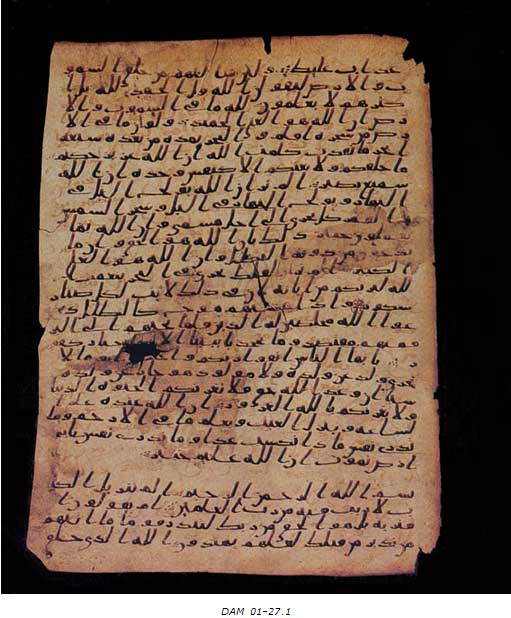
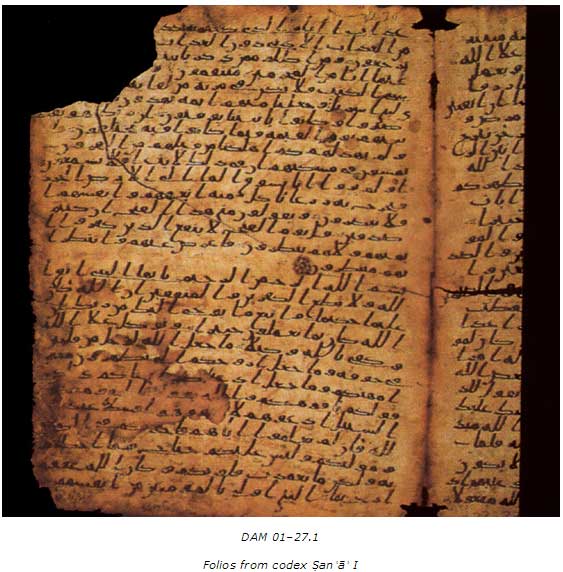
iii. No number. Sūrah An‘ām, verses 5-20. 1st century hijrah.
The script is Hijāzī. Location: Maktabah al-Jāmi‘ al-Kābir,
San‘ā (Yemen). Diacritics present.
iv. Side A: Sūrah Muddaththir, verses 1-27; Side B: Sūrah
Muddaththir, verses 34-56. The Sotheby’s 2004 fragment
contains Sūrah Hūd, verses 73-95. 1st century hijrah.
Location: A private collection in London. Script is Kufic.
Consonants are sparsely differentiated.
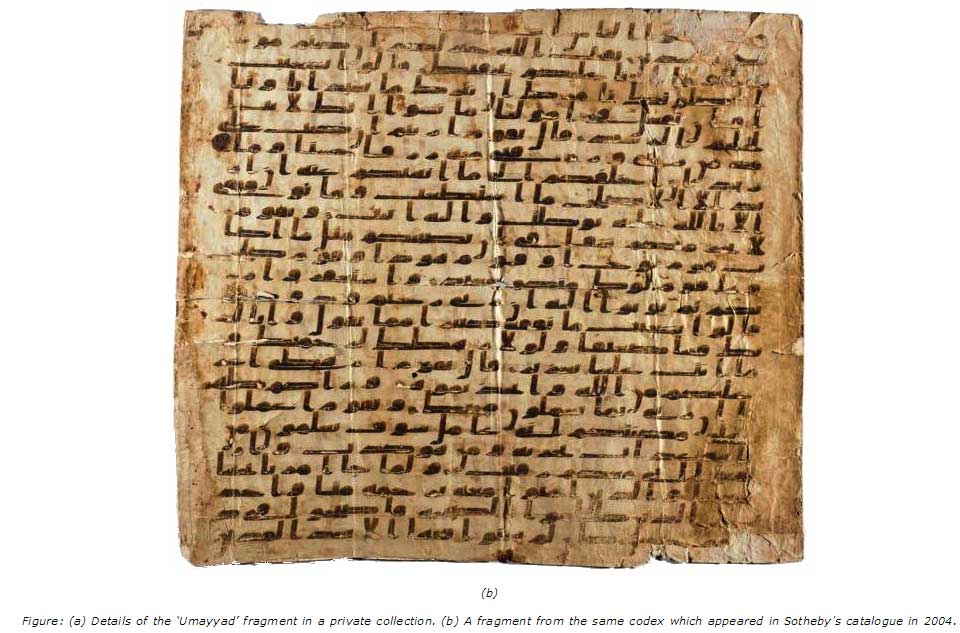
v. Arabe 328a. Miscellaneous verses. 1st century hijrah. The
script is Hijāzī. Location: Bibliothèque Nationale, Paris;
Biblioteca Apostolica Vaticana, Vatican City; Nasser D.
Khalili Collection of Islamic Art, London. Occasional
diacritical strokes. There is no vocalization. Reading of Ibn
‘Āmir.
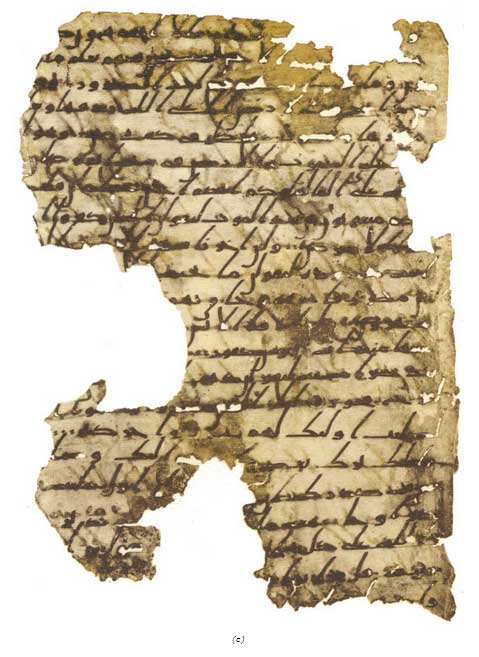
vi. MS. Or. 2165. Miscellaneous verses. 1st century hijrah.
The script is Hijāzī. Studied by Instisar Rabb and reassigned
the reading of Hims. Location: British Library, London UK. The
consonants are frequently differentiated by dashes.
vii. LNS 19
CAab. Surah Mā’idah, verse 89 to Sūrah An‘ām, verse 12. 1st
century hijrah. The script is Hijāzī. Location: Dār al-Athar
al-Islāmiyyah, Kuwait. This manuscript bears a striking
resemblance to the British Museum
Ms. Or. 2165. The consonants are frequently differentiated
by dashes.
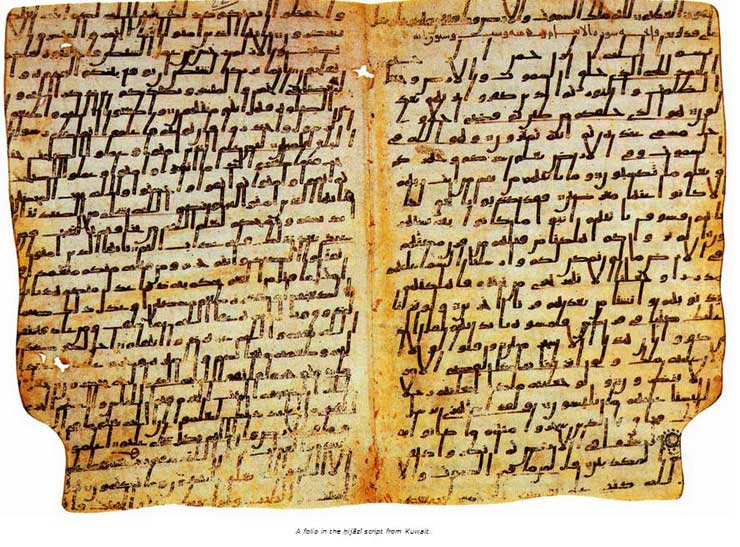
viii.
1611-mkh235. Sūrah Mā’idah, verses 7-12. 1st century hijrah.
Script is early kufic. Location: Bayt al-Qur’ān, Manama,
Bahrain. Diacritics present.
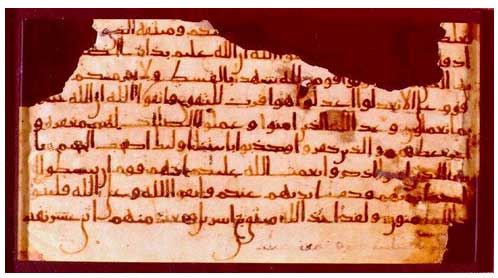
ix. Ms. Qāf 47. Miscellaneous Verses. 1st century hijrah. The
script is Hijāzī. Location: Staatsbibliothek zu Berlin,
Germany, and Dār al-Kutub al-Misriyyah, Cairo. The consonants
are differentiated by dashes.
x. QUR-1-TSR. Sūrah Mā’idah, verses 18-29. 1st century hijrah.
The script is Hijāzī. Location:
Tareq Rajab Museum, Kuwait. The consonants are frequently
differentiated by dashes.
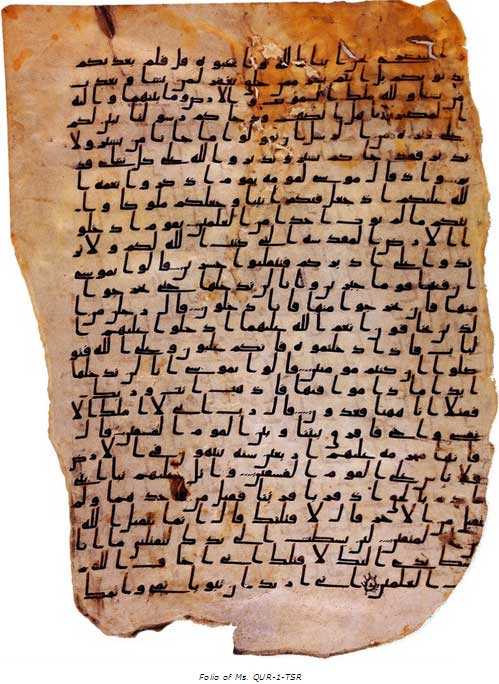
xi. Codex Ṣan‘ā DAM 01-25.1. Miscellaneous verses. 1st
century hijrah. The script is Hijāzī. Location: Dār al-Makhtūtāt,
Ṣan‘ā, Yemen. There are few diacritical marks.
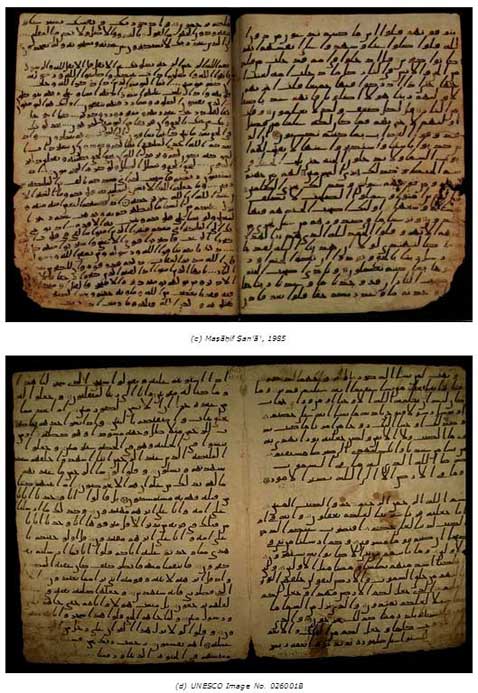
xii. DAM 01-29.1 Miscellaneous verses. 1st century hijrah. The
script is Hijāzī. Location: Dār al-Makhtutāt, Ṣanā, Yemen.
There are few diacritical marks.
xiii. M. 1572. Miscellaneous verses. 1st century hijrah. The
script is Hijāzī. Location: University of Birmingham,
Birmingham, UK. The consonants are differentiated by dashes.
The muṣḥaf is partly vocalized with red dots by a later (?)
hand.
xiv. No number. 1st century hijrah. The script is Hijāzī.
Location: Not known. Diacritical marks, where present,
consists of oval dots or angled dashes.
xv. DAM 01-28.1. Miscellaneous verses. 1st – 2nd century
hijrah. The script is Hijāzi. Location: Dār al-Makhtūtāt,
Ṣan‘ā, Yemen. Diacritical marks are frequent.
xvi. Codex Ṣan‘ā DAM 01-18.3. Sūrah Anfāl, verses 2-11 and
41-46. 1st – 2nd century hijrah. The script is Hijāzī.
Location: Dār al-Makhtūtāt, Ṣan‘ā, Yemen. Few diacritical
marks.
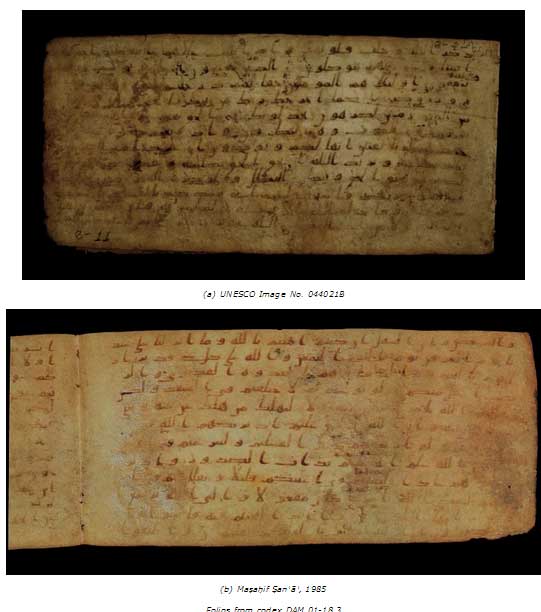
xvii. Codex Ṣan‘ā DAM 01-30.1 Miscellaneous verses. 2nd
century hijrah. The script is Hijāzī. Location: Dār al-Maktūtāt,
Ṣan‘ā, Yemen. Few diacritical marks.
xviii. Codex Ṣan‘ā DAM 01-29.2. Miscellaneous verses. 2nd
century hijrah. The script is kufic. Location: Dār al-Makhtūtāt,
Ṣanā, Yemen. Diacritical marks are sparsely distributed.
It may be of further interest to note that Giorgio Levi Della
Vida (d. 1967) has published one of the earliest partial
Qur’ān masāhif on parchment. It belongs to the first century
and is found in the Vatican Library. It begins with the fourth
verse of Sūrah Hūd. Diacritical dots are apparent.
IV. Conclusion
In the light of
this analysis, it can be gathered that the way traditional
Muslim sources ascribe the introduction of vocalization and
diacritics to certain personalities in the first century of
Islam is not sound. The roles alleged to have been played by
Abū al-Aswad al-Du’alī, Nasr ibn ‘Āsim and Yahyā ibn Ya‘mar
cannot be established historically through reliable means.
Empirical evidence also negates the traditional Muslim
account. Even the alleged development made by al-Khalīl ibn
Ahmad al-Farāhīdī in vocalization symbols stands on slippery
ground.
However, as far
as the scheme of vocalization and diacritics (both initially
represented by dots) is concerned, it does clearly appear in
the early manuscripts discovered. So the question arises on
the origin of this scheme. Who was responsible for it?
As far as the
dotting of similar letters is concerned, it can be said with
reasonable certainty that these dots were invented with the
invention of the alphabet. They were however sparingly used in
writing the Qur’ān since the reliance was primarily on oral
transmission. It seems that as written Qur’āns became more
pervasive to cater for the need of converts and for the
teaching of children etc the sparingly used dots gradually
gave way to dots being used everywhere on the letters that
needed it. The scheme of dotting similar letter thus would not
require that its originator be researched into and it be
ascribed to particular individuals.
As far as
vocalization is concerned, it seems quite plausible that this
is something which perhaps the Arabs borrowed from the Syriac
tradition to which they were exposed. Versteegh (b. 1947)
has pointed out the striking correlation between the Arabic
signs fatha, kasrah and dammah and the Syriac signs pētāhā
(opening), hēbāsā (pushing) and ēsāsā (contraction). In all
probability, the Syriac signs were also represented by
sublinear and supralinear dots.
When exactly was this dot notation introduced in Qur’ānic
manuscripts cannot be said with certainty. Manuscript studies
may help us ascertain this fact.
It would thus
be better to give up the long-standing view of ascribing to
certain personalities the origination of nuqat meant both for
vocalization and diacritics. Similarly, if it is correct to
conclude that al-Khalīl ibn Ahmad al-Farāhīdī had no role in
the second vocalization phase in which the dot notation was
changed to the dash/stroke notation, then the question may be
posed: Who was responsible for this? To the best of my
knowledge, the available material on this subject does not
give a clue to the answer of this question. However, this
development may have been the handiwork of an innovative
scribe who deemed black dotted notation for diacritics and the
red dotted notation of vocalization were becoming cumbersome
for the scribes and confusing for the readers. His idea
obviously was then picked up by many others. However, this is
merely a conjecture and at the moment lacks historical
corroboration.
________________________
|